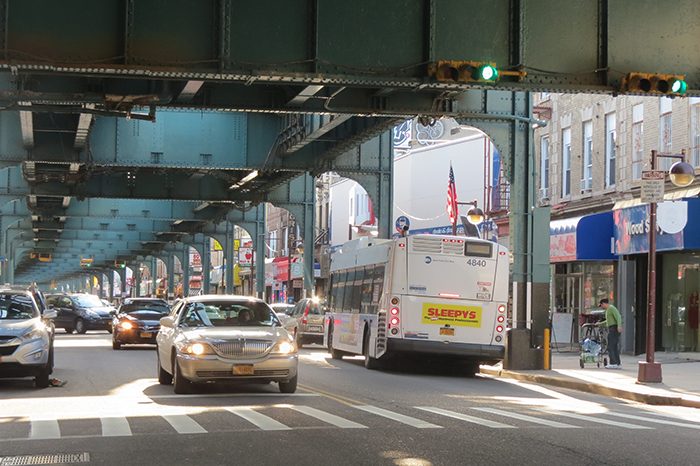File Photo
The analysis also explores recommendations to protect and promote retail businesses on storefront commercial strips such as Jamaica Avenue in Woodhaven.
By Michael V. Cusenza
One of the more prevalent, if perturbing, sights across the borough over the past couple of years is the number of vacant storefronts along once-bustling thoroughfares, such as Liberty Avenue and Jamaica Avenue.
The City Council has decided to get involved and do something about the problem. Gotham’s legislative body recently released “Planning for Retail Diversity: Supporting NYC’s Neighborhood Businesses, a detailed analysis of the challenges faced by New York City’s storefront business owners and a comprehensive set of recommendations to protect and promote retail businesses.
“As rising rents are threatening small businesses in hotter markets, many communities of color in the outer boroughs are starving for diverse commercial corridors,” said Councilman Donovan Richards (D-Laurelton), chairman of the Subcommittee on Zoning and Franchises. “While e-commerce is an increasingly impending threat, the recommendations laid out by the City Council are a comprehensive strategy that will help provide relief for business owners and expand high-quality retail for residents who normally leave their own neighborhoods to do their shopping. It was an honor to co-chair our Retail Diversity hearing and I look forward to working with my colleagues to move forward with this plan as soon as possible.”
The analysis breaks down the council’s recommendations into five themes: Citywide Planning, Data Collection & Research, Zoning and Land Use, Neighborhood Planning and Economic Development, and Tax Policy and Financial Incentives.
“There is a strong correlation between the strength of our small businesses and the health and well-being of our neighborhoods,” said Councilman Robert Cornegy, chairman of the Committee on Small Business. “When we find ways to promote and bolster the strength of our small businesses, our communities directly benefit. The importance of fostering retail diversity and shaping policies that allow small business owners to afford commercial space in the neighborhoods they serve is paramount to the success and sustainability of New York City’s economy. I look forward to moving many of the recommendations contained in this report forward with my colleagues in the Council and Mayor de Blasio over the course of the next four years.”
CITYWIDE PLANNING
• Designate the Department of Small Business Services (SBS) to manage planning and policy for retail storefronts
• Empower SBS to file land use applications related to retail space and commercial corridors
DATA COLLECTION & RESEARCH
• Collect and analyze storefront retail data in each community district as part of a citywide Commercial District Needs Assessment
• Require Storefront Vacancy Reporting
The council and administration should begin to address the prob¬lem of vacant storefronts by requiring landlords to register with SBS after a storefront has been vacant for 90 days and report on the status every 90 days thereafter. Registration could help SBS and others to identify corridors and neighborhoods where store¬front vacancies may be creating a barrier to achieving a healthy diverse mix of retailers.
• Study the impact of the growth of e-commerce on the brick-and-mortar retail sector and develop additional policies and programs to help small businesses adapt
ZONING AND LAND USE
• Expand Use of Special Enhanced Commercial Districts that require retail space on the ground floor of new development.
• Expand Special Enhanced Commercial Districts that restrict the size of storefronts.
• Examine Formula Retail Restrictions
• Study a potential zoning bonus for affordable retail space
• Prioritize affordable local retail space in city-sponsored developments where appropriate
• Eliminate special permit requirement for gyms and health clubs
NEIGHBORHOOD PLANNING & ECONOMIC DEVELOPMENT
• Help local nonprofits develop affordable commercial spaces in underserved areas
• Strengthen capacity for CDCs to engage in economic development work
• Create a Neighborhood Commercial Development Fund
• Create a Retail Diversity Fund
• Help incubator & entrepreneurship program graduates find storefront space
• Expand support for public markets and increase use of pop-up markets
• Reform regulation of street food vendors and increase the number of available permits
TAX POLICY & FINANCIAL INCENTIVES
• Create a new tax abatement and/or direct subsidy program to incentivize property owners to offer affordable long-term leases
• Property tax abatement to support affordable commer¬cial leases
• Direct Subsidy – Legacy Business Fund Model
• Reform the Commercial Rent Tax
“While headlines often go to major multinational corporations whose names adorn Manhattan skyscrapers, much of the economic engine of our city is contained in the countless storefronts that line our blocks,” said Council Speaker Melissa Mark-Viverito. “Retail and restaurant business owners employ 600,000 people and provide critical goods and services to our residents. Our report sets forth a policy agenda to ensure the diversity and character of our city is reflected by our community businesses. It is our hope that this report will serve as a blueprint for comprehensive policy to foster retail diversity, affordability, and access throughout all New York City neighborhoods.”
Benjamin Dulchin, executive director of the Association for Neighborhood and Housing Development added, “The report provides a timely and broad analysis of issues faced by small independent retail tenants across the five boroughs. It provides a robust template of policy solutions and recommendations to address these problems.”

